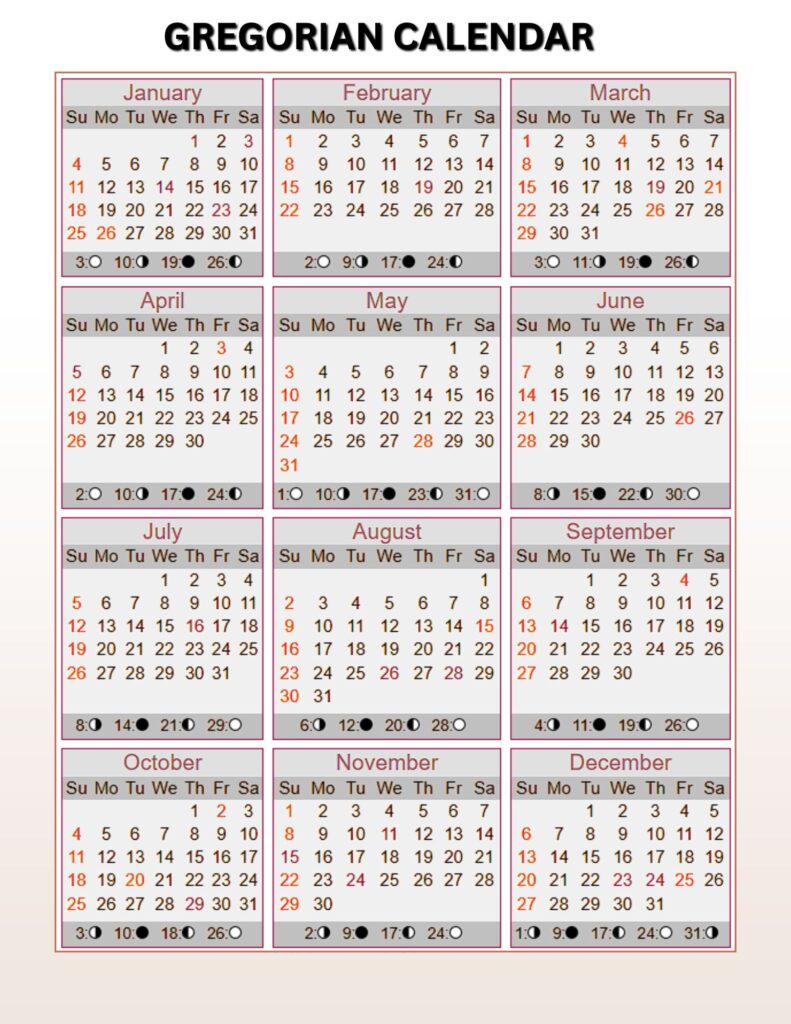Julian Calendar 2026 [Gregorian Calendar]
The Julian Calendar 2026 comes from the ancient system, which was introduced by Julius Caesar in 45 BC. Unlike the Gregorian calendar, the Julian calendar 2026 holds its leap year cycle. It adds a day every four years without fail. It makes a minor flow of about a day every 128 years compared to the solar year.

Some Orthodox Christian churches still use the Solar Calendar 2026 to determine dates for holidays such as Easter and Christmas. Historians and astronomers require a Julian Calendar 2026 to compare historical dates.
Julian Calendar 2026
The Julian Calendar 2026 will show how it differs from the widely used Gregorian system. Julius Caesar designed the Solar calendar, which was groundbreaking. It introduced a year length of 365.25 days. The Julian Calendar 2026 has 12 months, and February has 28 days. This is because 2026 is not a leap year. In this system, leap years happen every four years without fail. However, this leads to a gradual misalignment with the Earth’s orbit. The Gregorian reform of 1582 aimed to fix this issue.
Gregorian Calendar

The Gregorian Calendar is the internationally accepted civil calendar.
- Introduced by Pope Gregory XIII in 1582 to reform the Solar calendar.
- Adjusts leap years: years divisible by 100 are not leap years unless they are also divisible by 400.
- Solved the issue of calendar drift that affected the Julian system.
- Utilized across the globe for civil, cultural, and commercial purposes.
- Aligns with the solar year, which consists of 365.2425 days.
Solar Calendar
| Month | Start Date | End Date | Total Days | Notable Info |
|---|---|---|---|---|
| January | Thursday, Jan 1 | Friday, Jan 31 | 31 days | New Year: Jan 1 |
| February | Saturday, Feb 1 | Friday, Feb 28 | 28 days | Leap year? ❌ (No) |
| March | Saturday, Mar 1 | Monday, Mar 31 | 31 days | Spring Equinox: Mar 20 |
| April | Tuesday, Apr 1 | Wednesday, Apr 30 | 30 days | |
| May | May 2025 | Saturday, May 31 | 31 days | |
| June | Sunday, Jun 1 | Monday, Jun 30 | 30 days | Summer Solstice: Jun 21 |
| July | Tuesday, Jul 1 | Thursday, Jul 31 | 31 days | |
| August | Friday, Aug 1 | Sunday, Aug 31 | 31 days | |
| September | September 2025 | Tuesday, Sep 30 | 30 days | Autumn Equinox: Sep 22 |
| October | Wednesday, Oct 1 | Friday, Oct 31 | 31 days | |
| November | Saturday, Nov 1 | Sunday, Nov 30 | 30 days | |
| December | Monday, Dec 1 | Wednesday, Dec 31 | 31 days | Winter Solstice: Dec 21 |
A solar calendar is a calendar system based on the revolution of the Earth around the Sun, ensuring that the dates align with continuous seasonal changes. The Gregorian calendar, the world’s most widely used calendar, is a sophisticated solar calendar. The Julian is also solar, but is less accurate due to its simple leap year rule. Solar calendars are essential for agricultural societies as they help predict seasonal patterns for planting and harvesting. By monitoring the tropical year, the solar calendar maintains events such as consistently attached and equal. Many ancient civilizations, such as Egypt and Persia, developed early solar calendars.
Difference Between Julian and Gregorian Calendars
The Julian vs. Gregorian Calendar debate shows key differences between these two systems. The Julian calendar has a simple leap year rule, causing an 11-minute drift each year. The Gregorian reform fixed this by skipping some leap years to stay in sync with the solar year. Today, most people use the Gregorian Calendar. However, the Julian calendar is still used for traditional church purposes and to convert historical dates.
Q1. What is the Julian Calendar 2026?
Julian Yearbook 2026. The following is a series of matrices for each month of the Julian 2026 and, for comparison purposes, the corresponding dates associated with other calendars currently in use in different parts of the world, such as the Gregorian Calendar.
Q2. Is 2026 a leap year in the Julian calendar?
Yes, 2026 is a leap year in the Julian Calendar, as you can see that it is perfectly divisible by 4.
Q3. What is the difference between the Julian Calendar 2026 and the Gregorian Calendar 2026?
Dates in the Julian Yearbook are 13 days behind other systems. For instance, Julian January 1, AD 2019, is equivalent to Gregorian January 14, AD 2019.
Q4. Why do some countries and churches continue to use the Julian Calendar in 2026?
A few Orthodox Christian organizations still employ the Julian Yearbook as a basis for their model (Russian Orthodox and Serbian Orthodox).
Q5. How many days are in the Julian calendar 2026?
2026 is a leap year; therefore, it has 366 days.
